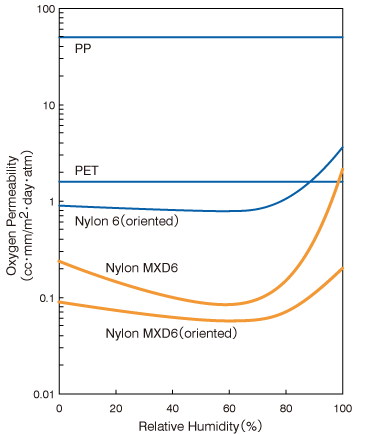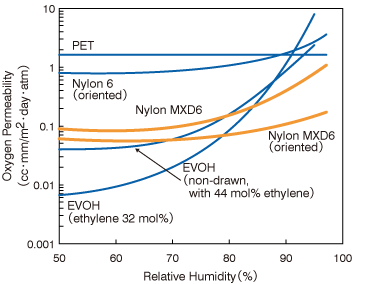Gas Barrier Properties
Table 3 compares the oxygen transmission coefficient of Nylon-MXD6 film and various other polymer films. Fig. 2-1 shows how the oxygen transmission coefficient is related to humidly. Nylon-MXD6 shows greater gas-barrier characteristic against oxygen than other polymers such as Nylon 6, PET and acrylonitrile co-polymerized resin. Fig. 2-2 shows the oxygen transmission coefficient in a high humidity environment. Nylon-MXD6 retains its excellent gas-barrier characteristic even under high humidity. Nylon-MXD6 is especially useful since it retains its gas-barrier qualities after retorting.
| Films | Oxygen Permeation rate (cc/m2·day·atm)20µm, 23℃ |
||
|---|---|---|---|
| 60%RH | 80%RH | 90%RH | |
| Nylon-MXD6 (oriented:4 x 4) | 2.8 | 3.5 | 5.5 |
| Nylon-MXD6 (Non-oriented) | 4.3 | 7.5 | 20 |
| Ethylene Vinylalcohol Copolymer (Ethylene:32mol%) |
0.5 | 4.5 | 50 |
| Ethylene Vinylalcohol Copolymer (Ethylene:44mol%) |
2.0 | 8.5 | 42.5 |
| Acrylonitrile copolymer | 17 | 19 | 22 |
| Nylon 6 (oriented) | 40 | 52 | 90 |
| Nylon 6 (oriented, PVDC coated) |
10 | 10 | 10 |
| Polyethylene Terephthalate (oriented) |
80 | 80 | 80 |
| Polypropylene (oriented) | 2,500 | 2,500 | 2,500 |
| Polypropylene (PVDC Coated) | 14 | 14 | 14 |
Fig.2-1 Humidity Dependent Oxygen Permeability of Various Polymers (23℃)

Fig.2-2 Oxygen Permeability of Various Polymers under High Humidity (23℃)

Inquiries Concerning Products
Green Energy & Chemicals Business Sector
High-performance Products Division
HP Material Department
TEL:+81-3-3283-4800 / FAX:+81-3-3214-0938
